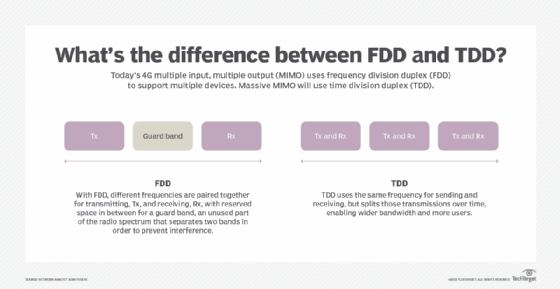MIMO (multiple input, multiple output)
What is MIMO (multiple input, multiple output)?
MIMO (multiple input, multiple output) is an antenna technology for wireless communications in which multiple antennas are used at both the source (transmitter) and the destination (receiver). The antennas at each end of the communications circuit are combined to minimize errors, optimize data speed and improve the capacity of radio transmissions by enabling data to travel over many signal paths at the same time.
Creating multiple versions of the same signal provides more opportunities for the data to reach the receiving antenna without being affected by fading, which increases the signal-to-noise ratio and error rate. By boosting the capacity of radio frequency (RF) systems, MIMO creates a more stable connection and less congestion.
The importance of MIMO for users
The 3rd Generation Partnership Project (3GPP) added MIMO with Release 8 of the Mobile Broadband Standard. MIMO technology is used for Wi-Fi networks and cellular fourth-generation (4G) Long-Term Evolution (LTE) and fifth-generation (5G) technology in a wide range of markets, including law enforcement, broadcast TV production and government. It also can be used in wireless local area networks (WLANs) and is supported by all wireless products with 802.11n.
MIMO is often used for high-bandwidth communications where it's important to not have interference from microwave or RF systems. For example, it's frequently used by first responders who can't always rely on cell networks during a disaster or power outage or when a cell network is overloaded.
Wi-Fi 6 -- also known as 802.11ax -- raised the bar for wireless connectivity by introducing several new technologies to help eliminate the limitations associated with adding more Wi-Fi devices to a network. Wi-Fi 7 is currently in development with an expected release in 2024.
Before MIMO, there were other types of advanced antenna technology with different configurations -- most commonly, multiple input, single output (MISO) and single input, multiple output (SIMO). MIMO builds on these technologies.
LTE applications of MIMO
MIMO is one of the most common forms of wireless, and it played a key role in the deployment of LTE and the wireless broadband technology standard Worldwide Interoperability for Microwave Access (WiMAX>). LTE uses MIMO and orthogonal frequency-division multiplexing (OFDM) to increase speeds up to 100 megabits per second (mbps) and beyond. These rates are double what was offered in previous 802.11a Wi-Fi. LTE uses MIMO for transmit diversity, spatial multiplexing (to transmit spatially separated independent channels), and single-user and multiuser systems.
MIMO in LTE enables more reliable transmission of data, while also increasing data rates. It separates the data into individual streams before transmission. During transmission, the data and reference signals travel through the air to a receiver that will already be familiar with these signals, which helps the receiver with channel estimation.
MIMO and 5G massive systems
MIMO continues to upgrade and grow through its use in massive new applications, as the wireless industry works to accommodate more antennas, networks and devices. One of the most prominent examples of this is the rollout of 5G technology.
These massive 5G MIMO systems use numerous small antennas to boost bandwidth to users -- not just transmission rates as with third-generation (3G) and 4G cellular technology -- and support more users per antenna. Unlike 4G MIMO, which uses a frequency division duplex (FDD) system for supporting multiple devices, 5G massive MIMO uses a different setup called time division duplex (TDD). This offers numerous advantages over FDD (see image below).

MIMO and beamforming
Beamforming is an RF management technique that maximizes the signal power at the receiver by focusing broadcast data to specific users instead of a large area. With 5G, three-dimensional (3D) beamforming forms and directs vertical and horizontal beams at the user. These can reach devices even if they're at the top of a high-rise, for example. The beams prevent interference with other wireless signals and stay with users as they move throughout a given area.

SU-MIMO vs. MU-MIMO
There are two primary types of MIMO: single-user (SU) and multiuser (MU). In SU-MIMO systems, data streams can only interact with one device on the network at a time. MU-MIMO systems, therefore, outperform SU-MIMO.
Issues arise with SU-MIMO when many users attempt to use the network simultaneously. If one person is uploading video and another is conferencing, the data stream will choke, causing latency, or delays, to skyrocket. On the other end of the spectrum, MU-MIMO has the advantage of being able to stream multiple data sets to multiple devices at a time.
There are various possible configurations for these MIMO systems, with 2x2, 4x4, 6x6 and 8x8 being the most common. 5G massive systems manipulate these configurations to enable extensive network capacity.

MIMO's primary advantages
In its various configurations, MIMO has a number of advantages over MISO and SIMO advanced antenna technologies:
- MIMO enables stronger signals. It bounces and reflects signals so a user device doesn't need to be in a clear line of sight.
- Video and other large-scale content can travel over a network in large quantities. This content travels more quickly because MIMO supports greater throughput.
- Many data streams improve visual and auditory quality. They also decrease the chance of lost data packets.
How massive MIMO systems are influencing the future
MIMO is a primary tool for advancing all aspects of wireless communications. It plays a substantial role in 5G technology and is influencing how users interact with these technologies daily. These influences include the following:
- High network capacities. Data travels to more users through the deployment of 5G New Radio (5G NR). MU-MIMO and 5G NR enable more users to access data at the same frequency and time rates.
- More coverage. Users can soon expect high-speed data wherever they are, even at the edge of service areas. Using 3D beamforming, the coverage adapts to the user's movement and location.
- Better user experience (UX). Watching videos and uploading content is easier and faster. Massive MIMO and 5G technology transform UX.







